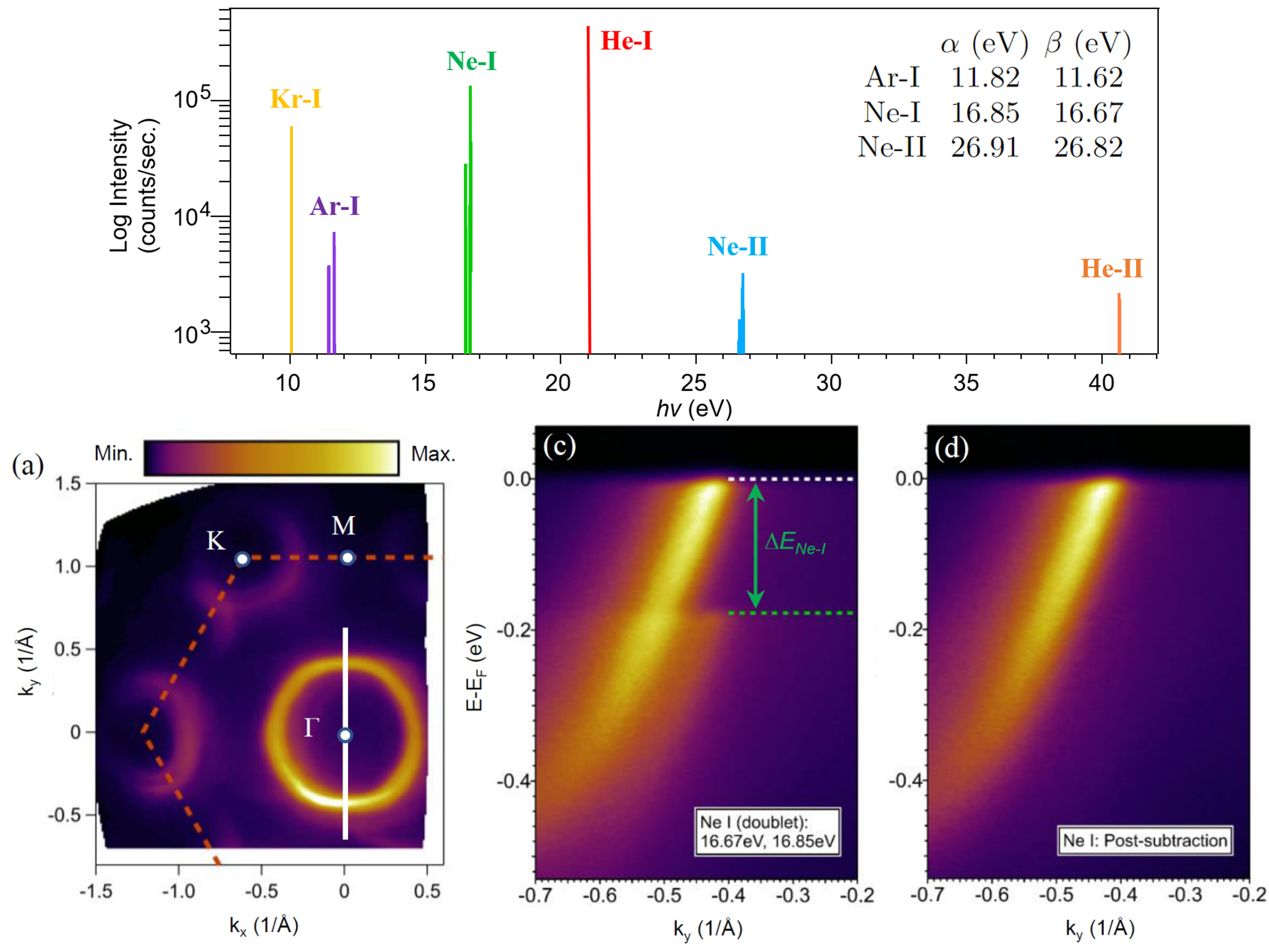PARADIM Highlight #79—In-House Research (2023)
B.D. Faeth, K.M. Shen, and D.G. Schlom (Cornell University) T.M. McQueen (Johns Hopkins University)
Angle-resolved photoemission spectroscopy (ARPES) is a powerful tool for characterizing the electronic structure of quantum materials. A key component in any ARPES setup is the ultraviolet photon source, with its characteristics largely defining the system’s capabilities. Lab-based ARPES systems valued for their ease of access mostly rely on noble gas discharge lamps, which produce a series of intense narrow emission lines at discrete photon energies depending on the gas plasma used. A critical shortcoming of these sources is the limited number of useful emission lines available – historically only He-Iα (21.2 eV) and He-IIα (40.8 eV) lines have found practical use in ARPES experiments. Although other bright VUV emission lines can be generated by using different discharge gases (such as Ne, Ar, Kr, or Xe), many of these intrinsically include closely spaced “doublet” emission lines, which result in superimposed replica features when used as an ARPES source, severely limiting their experimental usefulness.

Here, PARADIM’s In-House Team developed a simple algorithmic method to separate the two components from ARPES spectra collected with doublet emission sources. Benchmark measurements on well-characterized 2D materials demonstrate that doublet spectra processed with this approach reliably produce accurate dispersion relations and quasiparticle lifetimes matching data from pure, monochromated sources. This method therefore successfully unlocks a wide range of critically useful additional photon energies to any lab with multi-gas discharge lamps at virtually no additional cost.
A critical shortcoming of lab-based plasma UV sources for photoemission spectroscopy is the limited number of useful emission lines available – historically only He-Iα (21.2 eV) and He-IIα (40.8 eV) lines have found practical use in ARPES experiments. Although other bright VUV emission lines can be generated by using different discharge gases (such as Ne, Ar, Kr, or Xe), many of these intrinsically include closely spaced “doublet” emission lines, which result in superimposed replica features when used as an ARPES source, severely limiting their experimental usefulness. Here, PARADIM’s in-house team has developed a simple computational approach to processing ARPES data collected with such doublet emission sources, based on a piece-wise reconstruction algorithm. Our method effectively subtracts the contribution of these doublet emission lines from angle-resolved photoemission spectra in a computationally simple and practical way. Furthermore, by benchmarking against ARPES spectra of well-characterized 2D materials, we demonstrate that doublet spectra processed with this approach reproduce the key features of monochromated He-Iα spectra, reliably reproducing quantifiable dispersion relations and quasiparticle lifetimes.
As some of the available doublet discharge lines such as Ne-II (26.91 eV), Ne-I (16.85 eV), and Ar-I (11.82 eV) lie at convenient energy spacings relative to He-Iα and He-IIα, these added energies significantly improve the effectiveness of lamp-based systems, particularly in the study of 3D materials where probing an array of out-of-plane momentum regions is of great utility. We expect that labs with ready access to such multi-gas discharge lamps may benefit from this method at no additional expense, unlocking these additional photon energies for widespread use in lab-based ARPES studies on quantum materials.
This project made use of the state-of-the art Angle Resolved Photoemission Spectroscopy (ARPES) system in PARADIM’s Thin Film Growth Facility to perform benchmark measurements of suitable 2D quantum materials. In particular, access to the next-generation high-intensity multi-gas plasma discharge lamp as part of this system was critical for this study.
The work was conceived and performed by members of PARADIM’s In-House Research Team.
Y. Tarn, M. Sinha, C. Pasco, D.G. Schlom, T.M. McQueen, K.M. Shen, B.D.Faeth "An algorithm for subtraction of doublet emission lines in angle-resolved photoemission spectroscopy" Journal of Electron Spectroscopy and Related Phenomena 265 (2023) 147323.
This work was supported by the National Science Foundation [Platform for the Accelerated Realization, Analysis, and Discovery of Interface Materials (PARADIM)] under Cooperative Agreement No. DMR-2039380.







